Welcome to FISH FOOD TIMES
Aug. 2017 issue No.164

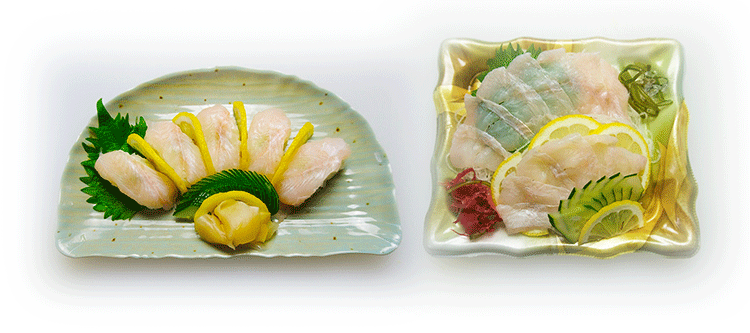
Four-line tongue-sole nigiri sushi & usutsukuri sashimi
The name is flounder? But, tonguefish is a flatfish fellow.
Let's write about sole that makes confusing distinction this month.
The following image is the Four-line tongue-sole of Cynoglossidae family, Pleuronectiformes order, which is the material of sashimi and sushi in page top images.


The general name in Japan is simply accepted as sitabirame, and the surface of the eyed side is dark like the image, so it is also called kuroshitabirame, kurobero, kurobeta. The official Black cow-tongue is Paraplagusia japonica belonging to Pleuronectiformes order, Cynoglossidae family, Paraplagusia genus, which is a different species from this Four-line tongue-sole.
When looking at the Four-line tongue-sole of the above image from side without eyes, the surrounding fillets are whitish, but the black cow-tongue in the image below is blacked out of the side without eyes fins and the entire surface of side with eyes Is also the difference that it is darker than the brownish black of the Four-line tongue-sole.
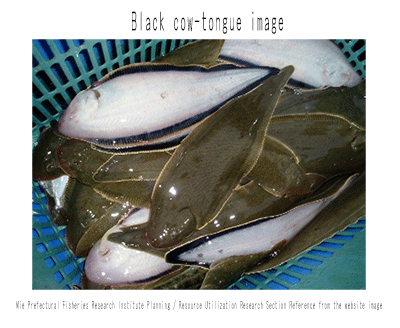
Also, other members of the Cynoglossidae family are also based on reddish brown rather than black, which is very difficult for ordinary people to distinguish, Red tonguefish, Three-line tongue-sole, Tonguefish , And so on.
Because they are often referred to as Red tonguefish in many cases, this article is not a detailed comparison, but to compare Four-line tongue-sole and Black cow-tongue below, only Cynoglossidae family Cynoglossus genus Red tonguefish Let's introduce it with images.
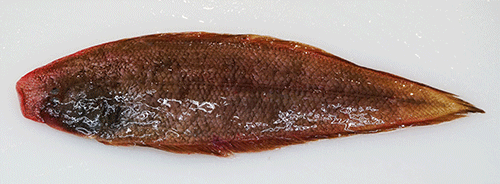
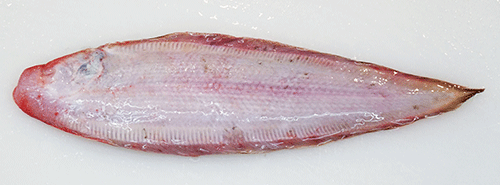
Red tonguefish is the season when it is high in summer as the rainy season and the season is the most delicious and cheapest in the year. In the regional fish shop facing the Ariake Sea, you can see the sights that are being actively being sold now in the form like the image below during the summer.
| Retail scene of Red tonguefish at fish store as of July | |
|---|---|
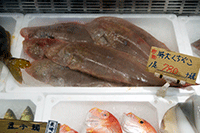 |
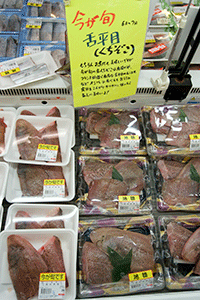 |
| Large size is 1 fish 780 yen ~ 980 yen | |
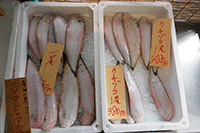 |
|
| Small size is one fish 380 yen ~ 480 yen | The fillets are small size one fish 398 yen, large size 100g 198 yen |
Red tonguefish is similar in shape to "shoe sole", so it is called Kutuzoko, Kuchizoko etc. in the area facing the Ariake Sea in Kyushu, and it is eaten mainly by boiling etc. as under picture.
In English names are called Red tonguesole and Red tonguefish, and it is the same that is also expressed like a red tongue or a red shoe sole.
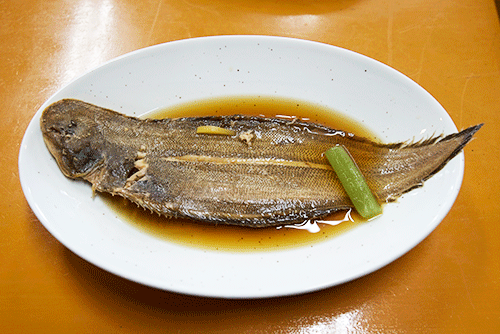
Boiled Red tonguefish Fukuoka prefecture Yanagawa city Yoake Chaya cuisine (early July 2017)
What is genuine sole muniel・・・?
However, in general, when asking the name of sole, I think that there are many people refreshingly thinking of the dish "French cuisine Sole meuniere". Famous for high-class dishes in European countries such as France, this fish is classified as the animal kingdom type Soleidae family European sole, and the alias is also called the name of Dover Sole.
The image below is Sole meuniere I ate at a restaurant in the hotel I stayed in Paris I visited at the end of October 2010.
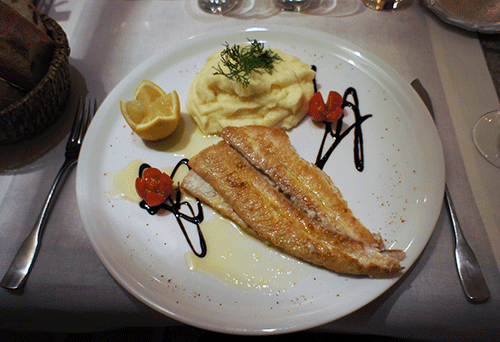
Sole entiere grilee au meuniere €28 Hotel Bedford (Paris)
As I saw this delicious dish that I had carried, I remember feeling it was quite different from the form of Japanese sole I knew, because it is bigger than I expected and massive.
That question was to be resolved later, but now I do not have a picture of Dover Sole. Therefore, as a means to explain that, Pardachirus Günther genus, Synaptura marginata Boulenger Species, which belong to the same kind of Pleuronectiformes order, Soleoidea suborder, Soleidae family, will be introduced below.
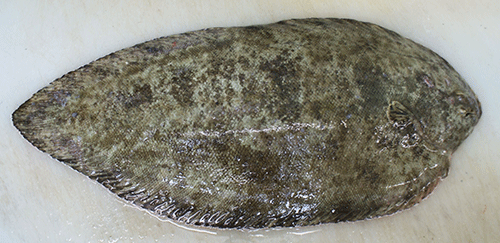

As you can see, the red tonguefish of the Cynoglossidae Jordan family is different, the white-margined sole of the Soleidae bonaparte family is slightly rounded, short and thick, the impression of put in the mouth but tough.
I tried disassembling this into three as follows.
| Disassembling into three pieces of white-margined sole |
|---|
 |
| 1, In the case of the Cynoglossidae family, basically it takes the skin from the head, in this case I took the skin from the tail experimentally. |
 |
| 2, I could smoothly remove the skin without applying force. |
 |
| 3, The middle bone part after disassembling into three pieces is larger than expected. |
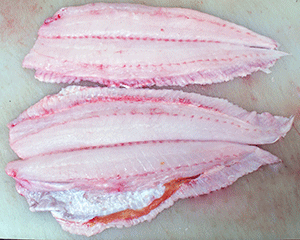 |
| 4, The side before disassembling into three pieces is side with eyes, the back is side without eyes. |
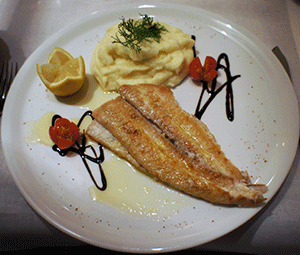 |
| When I reconfirm the image of sole muniel provided at the restaurant in Paris, I can understand that the dishes of this dish are arranged with "side with eyes half-skinned side down". Also, I think that the part of engawa, which is regarded as valuable in Japan, is trimmed off and it can be understood that its shape is thinner than originally. |
As for how this European sole (Dover Sole) is sold in retail stores in France, I borrowed a rental car in France I visited seven years ago, and it is called CHAVILLE near Versailles near Paris In a small town, we discovered by chance that two fishmongers are lined up in a market. Not only Europe Sole (Dover Sole) but also various fish were sold there. At that time I have detailed in FISH FOOD TIMES November 2010 No. 83, so please look through that article.
In that shop, European sole (Dover Sole) was sold in the form like the image below.
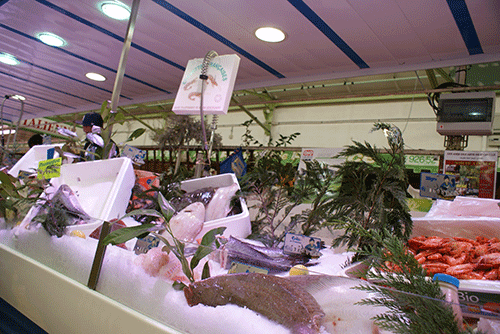
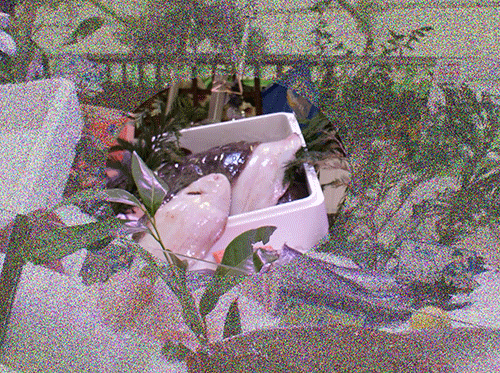
Where fresh fish and frozen fish were also displayed on the ice in the form of face-to-face sale, as in the enlarged image below, it was made to be thrown into a box of Styrofoam, and Europe sole (Dover Sole) were lined up. I did not check the price well, so it's not at all remembered, but of course it seemed that the treatment was not premised on eating raw.
Positioning of sole in Japan
It is common sense in Japan that "sole is not eaten with sashimi" is common sense, but it is only from the history so far that there was no custom of eating raw, "Sashimi and sushi should not eat" It is considered not meaning.
Since the skin of the Soleidae family is hard, when removing it to Muniel etc., it is common sense to remove the leather, and since the skin of Soleidae family actually treated was actually very hard, the skin was removed I thought it was better. However, Red tonguefish etc. of Cynoglossidae family seems to be unnecessary to remove leather, especially when boiling, without removing the skin there is no problem at all, for example Yoake cyaya introduced at the front part of this page The kuchizoko cooked dish which was served was also boiled with the leather as it was, it had no problem and it was possible to put chopsticks in the leather just like ordinary fish.
Even though you do not need to remove the skin like the oleidae family when you cook the fish of the ynoglossidae family, if you are removing the leather, if the freshness is good in Japan, I thought that it is usual to make it as sashimi or sushi, I made sashimi and sushi in the picture of the beginning and tasted it.
Not because it was delicious to eat somewhere, but because the freshness of the acquired Four-line tongue-sole was good, I decided to eat it with sashimi or sushi and experienced that raw taste only after I was born. Originally flats and flatfish 's colleagues have a good taste overall, so try cooking on the premise that Four - line tongue - sole can not be bad taste, after all, it is really different from my forecast It was a good taste.
Below, I will show the process of removing the skin of Four-line tongue-sole.
| Four-line tongue-sole skin removal process | ||
|---|---|---|
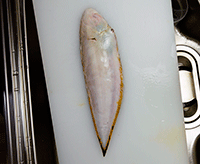 |
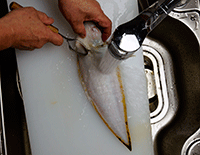 |
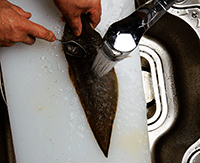 |
| 1, Prepare the Four-line tongue-sole. | 2, Remove scales of side without eyes. | 3, Remove scales of side with eyes. |
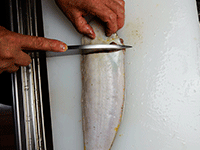 |
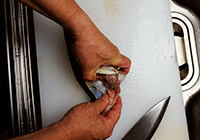 |
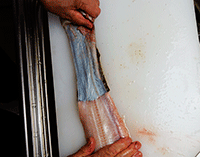 |
| 4, Cut in knives from the side of the breast billet of side without eyes, leave only the skin and finish cutting. | 5, Put side without eyes down, grab the head with the left hand, and pull the head toward the tailbill. | 6, Hold down the fish body with your right hand, pull it toward the tailbill while gripping the head with your left hand. |
 |
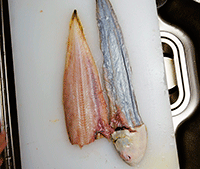 |
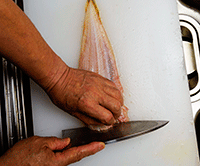 |
| 7, Pull with the left hand until the end of the tailbill, remove the skin. | 8, the state with the skin separated with the skin and head of side with eyes attached. | 9, With side without eyes facing down, leave the skin at the end on the head side and make a knife cut. |
 |
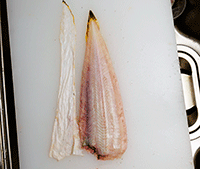 |
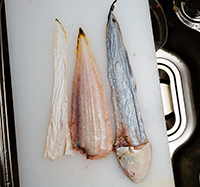 |
| 10, Return side without eyes up, grasp the skin with the left hand from the incision and pull it towards the tailbill. | 11, state after removing the skin of side without eyes. | 12, side with eyes and side without eyes, the state after removal of both skins. |
Since the stage of removing the skin is over, next is the process of three pieces disassembling and sashimi, and sushi neta cutting.
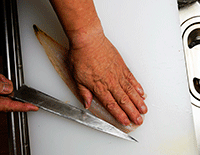 |
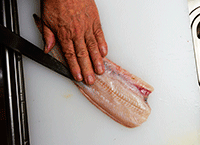 |
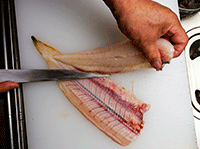 |
| 1, From the back body of side with eyes, using a yanagiba kitchen knife, make a notch on the middle bone. | 2, Slide on the middle bone, advance the cutting edge of yanagiba kitchen knife. | 3, Go beyond yamatakabone, go straight to the belly body. |
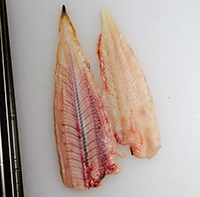 |
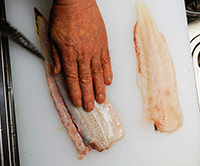 |
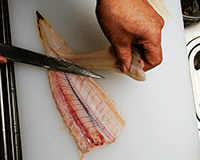 |
| 4, Side with eyes separated into two pieces disassembling. | 5, Next we will cut along the middle bone from the belly body side of side without eyes, using Yuji knife kitchen knife. | 6, Using Yanagi kitchen knife, go past yamatakabone and go down to the back body. |
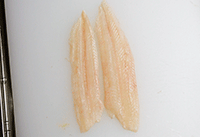 |
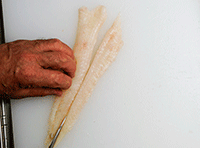 |
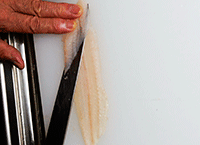 |
| 7, The body of both side with eyes and side without eyes who made three pieces disassembling. | 8, If the size is large, divide it into the back body and the belly body. | 9, Because it is thin slender body, decide the angle of the knife parallel to the edges of both bodies and cut off so that there is no waste. (Left posture) |
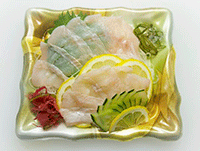 |
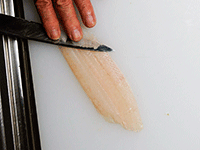 |
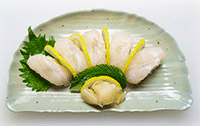 |
| 10, Four-line tongue-sole is not stiff like a flounder, so thinning is not easy, but the taste is really good. | 11, In order not to waste the posture of the right, decide the angle of the kitchen knife according to the angle of the edge of the body, and go forward. | 12, In the case of nigiri sushi, it is thicker and bigger than usutsukuri sashimi, it can not feel delicious. |
Japanese style · · ·, sole tempura
Finally, I will introduce sole tempura, which is also not very common.
Friends of sole are essentially soft materials, so if you cook boiled fish disintegrated and sometimes it is hard to pick up with chopsticks, so if you wrap it in tempula koromo, it becomes one lump and it becomes easy to eat.
Although Muniel may be the best European sole of Soleidae family as a dish, it seems that the thin slender body of the Cynoglossidae family is more suitable for tempura than Muniel.
Tempura at Four-line tongue-sole is an elegant taste peculiar to white fish and it is a really recommended dish.
| How to make Four-line tongue-sole tempura | |
|---|---|
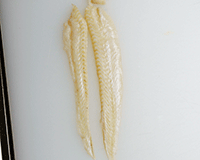 |
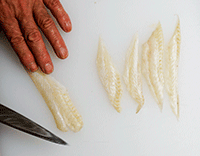 |
| 1, Four-line tongue-sole into two parts, the back body and the belly body. | 2, Cut into thin, long pieces to the size just as tempura. |
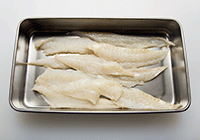 |
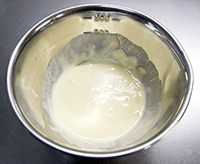 |
| 3, Four-line tongue-sole for the tempura trimmed to almost the same size, then sweetened with salt and pepper. | 4, Add cold water and eggs to flour and a small amount of potato starch, not blister, mix with a viscosity that leaves a little bit of flour. |
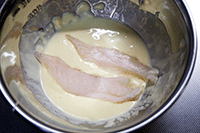 |
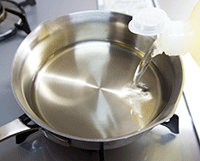 |
| 5, In a tempura koromo pickle the whole fillet of Four-line tongue-sole. | 6, Prepare tempura oil and bring the temperature to 180 ℃ |
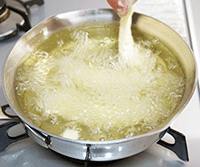 |
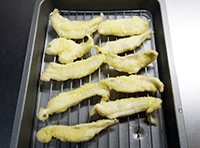 |
| 7, After putting ingredients in tempura oil, when the sunken item floats on top, return the back and front with chopsticks and take out when the color becomes even. | 8, Four-line tongue-sole made tempura. |
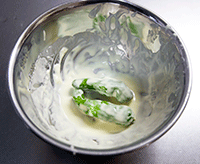 |
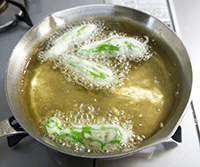 |
| 9. Put a few slits so that Shishito does not explode and attach the remaining tempura koromo to the surface. | 10, Temperature of oil slightly lower at 170 ℃, and return the right side and wrong side with chopsticks, fry shishito. |
 |
 |
| 11, Fried Four-line tongue-sole and Shishitou. | 12, complete with plenty of tempura on top of shikigami. |
Let's arrange sole in Japanese style and eat it.
Fish of the Cynoglossidae family, which is commonly called sole, including Red tonguefish and Four-line tongue-sole, are caught a lot at the same time because of bottomed net fishing, so at such times there is a tendency for the price to go cheap at a time, as a typical delicatessen fish limited to boiling and the like has been treated.
However, in recent years there have been influences such as French cuisine sole Muniel etc., its status seems to have been higher than before, but there seems to be reality that it can not be thought that the cooking method has expanded greatly since then.
As mentioned above, the fish used for the original sole Muniel is a different kind of fish of the Soleidae family, and even if you forcibly make fish of the Cynoglossidae family for Muniel cooking in the same way, there is a limit in taste if you compare them I feel it.
I think that the dish that makes the best use of the fish of the Cynoglossidae family in Japan is Japanese dishes such as "sashimi, sushi, tempura" etc.
Among the sole species captured by the bottom draw net, those still alive are also sold at the fish storefront, and because Japan that sole of such freshness is circulating in the market, you should do more Japanese way of eating.
An opinion and the communication are to iinfo@fish food times
Date of updating 1 Aug. 2017
